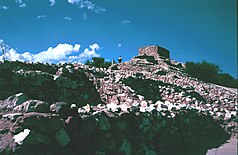Tuzigoot National Monument
| Tuzigoot National Monument | ||
|---|---|---|
| Top of the pueblo | ||
|
|
||
| Location: | Arizona , United States | |
| Specialty: | Sinagua culture pueblo | |
| Next city: | Cottonwood | |
| Surface: | 0.2 km² | |
| Founding: | July 25, 1939 | |
| Visitors: | 108,300 (2005) | |
Tuzigoot National Monument is a memorial of the type of National Monuments in Yavapai County in the US state of Arizona . It protects a large pueblo of the Sinagua culture from the 12th to 14th centuries.
The National Monument was dedicated in 1939 and is administered by the National Park Service . The area of the reserve is almost 20 hectares, which were donated by donors of the federal government in 1939 for the reserve, which was designated by President Franklin D. Roosevelt . The formal dedication covers around 3.2 km², of which only the 5% are actually claimed that are federally owned thanks to the donation.
The name Tuzigoot comes from the Apache language and means "curved" or "curved water", after the meandering course of the Verde River .
The pueblo
The Sinagua culture (after Harold Colton from Spanish: sin agua without water) colonized the Verde River valley in central Arizona from the middle of the 11th century. It developed after the eruption of the Sunset Crater volcano in 1064/65, whose fertile volcanic ash improved the conditions for arable farming in the predominantly semi - desert region. Cultural predecessors were the Hohokam -, the Anasazi - and the Mogollon cultures , whose different influences were mixed in the Sinagua culture.
The Tuzigoot pueblo was started around 1125. It stretches over a ridge of limestone and sandstone , about 35 meters above the river. Like other pueblos in the Verde River valley, they preferred elevated locations that could be defended well. In the last stage of expansion at the end of the 14th century, the pueblo comprised 110 rooms on three floors and was inhabited by over two hundred people. The residents grew the three typical crops of the southwest on the river bank: corn , beans and squash squash . Hunting and gathering were also carried out. The pueblos exported salt and cotton and imported mussel shells from the Gulf of California. The pueblo was abandoned around 1400 and the Sinagua culture perished. A change in climatic conditions or depletion of arable land due to overexploitation are discussed as reasons.
literature
- David Grant Noble: Ancient ruins of the southwest, an archaeological guide . Northland Publ. 1996. ISBN 0-87358-530-5 (pp. 155-157)
Web links
- National Park Service: Tuzigoot National Monument (official site; English)



